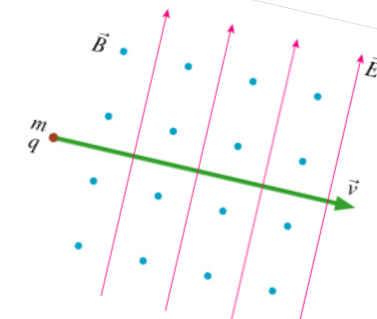The Velocity Selector In experiments where all the charged particles in a beam are required to have the same velocity (for example, when entering a mass spectrometer), scientists use a velocity selector. A velocity selector has a region of uniform electric and magnetic fields that are perpendicular to each other and perpendicular to the motion of the charged particles. Both the electric and magnetic fields exert a force on the charged particles. If a particle has precisely the right velocity, the two forces exactly cancel and the particle is not deflected. Equating the forces due to the electric field and the magnetic field gives the following equation: qE=qvBqE=qvB Solving for the velocity, we get: v=EBv=EB A particle moving at this velocity will pass through the region of uniform fields with no deflection, as shown in the figure. For higher or lower velocities than this, the particles will feel a net force and will be deflected. A slit at the end of the chamber allows only the particles with the correct velocity to pass.(Figure 1) Assuming the particle in the figure is positively charged, what are the directions of the forces due to the electric field and to the magnetic field? a. The force due to the electric field is directed up (toward the top of the page); the force due to the magnetic field is directed down (toward the bottom of the page). b. The force due to the electric field is directed down (toward the bottom of the page); the force due to the magnetic field is directed up (toward the top of the page). c. The force due to the electric field is directed out of the plane of the paper; the force due to the magnetic field is directed into the plane of the paper. d. The force due to the electric field is directed into the plane of the paper; the force due to the magnetic field is directed out of the plane of the paper. How does the kinetic energy of the particle in the figure change as it traverses the velocity selector? a. The kinetic energy increases. b. The kinetic energy does not change. c. The kinetic energy decreases. Suppose a particle with twice the velocity of the particle in the figure enters the velocity selector. The path of this particle will curve a. upward (toward the top of the page) b. downward (toward the bottom of the page) c. out of the plane of the paper d. into the plane of the paper Next, a particle with the same mass and velocity as the particle in the figure enters the detector. This particle has a charge of 2q2q - twice the charge of the particle in the figure. In this case, we can say that a. The force of the electric field on the particle will be greater than the force of the magnetic field. b. The force of the magnetic field on the particle will be greater than the force of the electric field. c. The forces of the electric and magnetic fields on the particle will still be equal.
The Velocity Selector
In experiments where all the charged particles in a beam are required to have the same velocity (for example, when entering a mass spectrometer), scientists use a velocity selector. A velocity selector has a region of uniform electric and magnetic fields that are perpendicular to each other and perpendicular to the motion of the charged particles. Both the electric and magnetic fields exert a force on the charged particles. If a particle has precisely the right velocity, the two forces exactly cancel and the particle is not deflected. Equating the forces due to the electric field and the magnetic field gives the following equation:
qE=qvBqE=qvB
Solving for the velocity, we get:
v=EBv=EB
A particle moving at this velocity will pass through the region of uniform fields with no deflection, as shown in the figure. For higher or lower velocities than this, the particles will feel a net force and will be deflected. A slit at the end of the chamber allows only the particles with the correct velocity to pass.(Figure 1)
| a. The force due to the electric field is directed up (toward the top of the page); the force due to the magnetic field is directed down (toward the bottom of the page). |
| b. The force due to the electric field is directed down (toward the bottom of the page); the force due to the magnetic field is directed up (toward the top of the page). |
| c. The force due to the electric field is directed out of the plane of the paper; the force due to the magnetic field is directed into the plane of the paper. |
| d. The force due to the electric field is directed into the plane of the paper; the force due to the magnetic field is directed out of the plane of the paper. |
| a. The kinetic energy increases. |
| b. The kinetic energy does not change. |
| c. The kinetic energy decreases. |
| a. upward (toward the top of the page) |
| b. downward (toward the bottom of the page) |
| c. out of the plane of the paper |
| d. into the plane of the paper |
| a. The force of the electric field on the particle will be greater than the force of the magnetic field. |
| b. The force of the magnetic field on the particle will be greater than the force of the electric field. |
| c. The forces of the electric and magnetic fields on the particle will still be equal. |

Trending now
This is a popular solution!
Step by step
Solved in 6 steps with 5 images









